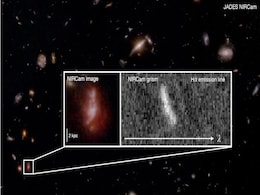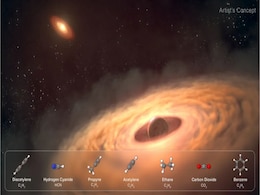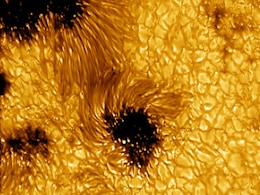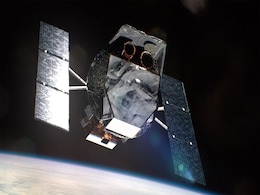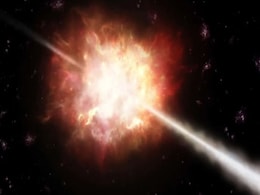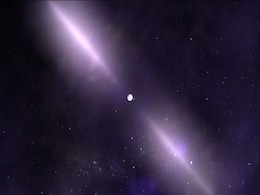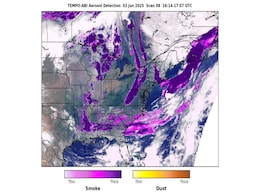Space And Astrophysics
- All
- News
- Videos
-

Mystery Deepens as Interstellar Comet 3I/ATLAS Brightens Unexpectedly Near the Sun
- Thursday November 6, 2025
- Written by Gadgets 360 Staff
Interstellar comet 3I/ATLAS defied expectations during its 2025 solar flyby, brightening far faster than predicted. Observatories worldwide recorded a blue coma rich in exotic gases, suggesting unique chemistry from another star system. Scientists are investigating whether its unusual composition or speed caused the outburst, marking a new interste...
-
 www.gadgets360.com
www.gadgets360.com
-

Dark Matter May Behave Like Ordinary Matter Under Gravity, New Study Finds
- Tuesday November 4, 2025
- Written by Gadgets 360 Staff
A new study shows dark matter falls into cosmic gravity wells much like ordinary matter, narrowing one of astronomy’s biggest mysteries. Researchers say any unknown force acting on dark matter must be very weak, though future missions could detect smaller effects. The findings bring scientists closer to understanding how the universe’s unseen m...
-
 www.gadgets360.com
www.gadgets360.com
-

LIGO Detect Possible Second-Generation Black Holes with Extreme Spins
- Sunday November 2, 2025
- Written by Gadgets 360 Staff
LIGO-Virgo-KAGRA observatories detected two extraordinary black hole collisions in late 2024—GW241011 and GW241110. The first involved a rapidly spinning black hole, while the second revealed one rotating opposite its orbit. These findings fit predictions for second-generation black holes, born from earlier mergers within crowded star clusters. T...
-
 www.gadgets360.com
www.gadgets360.com
-

James Webb Telescope Finds Early Universe Galaxies Were More Chaotic Than We Thought
- Thursday October 23, 2025
- Written by Gadgets 360 Staff
The James Webb Space Telescope has revealed that galaxies in the early universe were far more chaotic and unstable than once believed. A new study shows that gas turbulence and intense star formation disrupted young galaxies, reshaping scientists’ understanding of how galaxies evolved into the structured systems seen today.
-
 www.gadgets360.com
www.gadgets360.com
-

James Webb Offers First Glimpse Into How Moons Are Built Around Distant Planets
- Wednesday October 1, 2025
- Written by Gadgets 360 Staff
The James Webb Space Telescope has detected carbon-bearing molecules in a moon-forming disk surrounding CT Cha b, a massive planet-like object orbiting a young star 625 light-years away. The discovery marks the first measurement of its kind and offers clues to how moons like those around Jupiter and Saturn might have formed.
-
 www.gadgets360.com
www.gadgets360.com
-

Astronomers Capture Sharpest-Ever Solar Flare Images with NSF’s DKIST Telescope
- Wednesday August 27, 2025
- Written by Gadgets 360 Staff
Astronomers have achieved a major breakthrough by capturing the sharpest images of a solar flare ever recorded, using the National Science Foundation’s Daniel K. Inouye Solar Telescope (DKIST). Observed at the hydrogen-alpha wavelength during the decay of an X1.3-class solar flare, the images unveiled hundreds of ultra-fine coronal loops averagin...
-
 www.gadgets360.com
www.gadgets360.com
-

Scientists Apply Stephen Hawking's Theory to Propose Detectable ‘Black Hole Morsels’ in Space
- Thursday August 14, 2025
- Written by Gadgets 360 Staff
A new study suggests “black hole morsels” — tiny, asteroid-sized black holes from cosmic mergers — could emit detectable bursts of Hawking radiation. Observatories like HESS, HAWC, and Fermi may already hold clues. Detecting them could unlock insights into quantum gravity, unknown particles, and even hidden dimensions beyond the Standard Mo...
-
 www.gadgets360.com
www.gadgets360.com
-

Astronomers Observe Rare Supernova–Black Hole Interaction in Early Stages
- Sunday August 17, 2025
- Written by Gadgets 360 Staff
In a groundbreaking discovery, astronomers observed SN 2023zkd, a supernova that may have been triggered by close interaction with a black hole. Featuring unusual brightness peaks and extended pre-explosion activity, the event offers new insights into star black hole dynamics. Real-time AI detection played a key role, and upcoming surveys promise t...
-
 www.gadgets360.com
www.gadgets360.com
-

NASA Explores Industry Collaboration to Boost Swift Observatory’s Orbit and Extend Its Mission
- Friday August 15, 2025
- Written by Gadgets 360 Staff
NASA is partnering with U.S. firms to study boosting the Neil Gehrels Swift Observatory’s orbit, aiming to extend its scientific life and advance orbital servicing technologies. Funded through Phase III SBIR awards, the project explores cost-effective solutions while preserving Swift’s astrophysics role. Collaboration with Starfish Space may al...
-
 www.gadgets360.com
www.gadgets360.com
-

Brightest Gamma-Ray Burst Ever Observed Reveals Cosmic Secrets
- Friday August 1, 2025
- Written by Gadgets 360 Staff
On October 9, 2022, astronomers detected GRB 221009A, the most powerful gamma-ray burst ever recorded, earning the nickname “BOAT” (Brightest Of All Time). This rare, once-in-10,000-year event came from a galaxy 2 billion light-years away and temporarily blinded gamma-ray detectors. It revealed new insights into stellar death, as the associated...
-
 www.gadgets360.com
www.gadgets360.com
-

PSR J0922+0638 Pulsar Keeps Glitching Every 550 Days, Scientists Are Intrigued
- Thursday July 31, 2025
- Written by Gadgets 360 Staff
PSR J0922+0638, an ultradense neutron star, shows puzzling rotational glitches every 550 days. Using 22 years of radio data, scientists detected both abrupt and slow changes in its spin. These may be linked to magnetic field cycles or superfluid dynamics deep inside the star. However, the exact cause remains a mystery, demanding continued long-term...
-
 www.gadgets360.com
www.gadgets360.com
-

NASA TEMPO Satellite to Continue Tracking Pollution Hourly from Space Until 2026
- Saturday July 5, 2025
- Written by Gadgets 360 Staff
TEMPO, a collaborative space mission by NASA, NOAA, and the Smithsonian Astrophysical Observatory, is transforming air quality tracking across North America. Since 2023, it has delivered hourly, high-resolution pollution data from space, aiding researchers, health officials, and the public.
-
 www.gadgets360.com
www.gadgets360.com
-

Astronomers Capture First-Ever Image of a Dead Star That Exploded Twice in Rare Supernova Event
- Saturday July 5, 2025
- Written by Gadgets 360 Staff
Astronomers have captured the first-ever image of a white dwarf star undergoing a rare double-detonation supernova. Using the Very Large Telescope, the team revealed that such explosions can occur without a star reaching the Chandrasekhar limit. The findings, published in Nature Astronomy, could reshape existing theories about stellar death and imp...
-
 www.gadgets360.com
www.gadgets360.com
-

Webb Telescope Spots Possible Jellyfish Galaxy 12 Billion Light-Years Away
- Thursday July 3, 2025
- Written by Gadgets 360 Staff
Astronomers using the James Webb Space Telescope have identified a possible jellyfish galaxy about 12 billion light-years away. Named COSMOS2020-635829, it shows tentacle-like streams of gas and stars trailing off one side—likely formed through ram pressure stripping in a dense cluster. If confirmed, it would be the most distant jellyfish galaxy ...
-
 www.gadgets360.com
www.gadgets360.com
-

James Webb Telescope Detects Methanol and Ethanol Near Young Stars, Hinting at Life’s Origins
- Friday June 27, 2025
- Written by Gadgets 360 Staff
NASA’s James Webb Telescope has identified ethanol and methanol isotopes around protostars and HD 100453. These discoveries offer valuable clues about the cosmic origins of life, indicating that comets filled with organic molecules might have seeded early Earth.
-
 www.gadgets360.com
www.gadgets360.com
-

Mystery Deepens as Interstellar Comet 3I/ATLAS Brightens Unexpectedly Near the Sun
- Thursday November 6, 2025
- Written by Gadgets 360 Staff
Interstellar comet 3I/ATLAS defied expectations during its 2025 solar flyby, brightening far faster than predicted. Observatories worldwide recorded a blue coma rich in exotic gases, suggesting unique chemistry from another star system. Scientists are investigating whether its unusual composition or speed caused the outburst, marking a new interste...
-
 www.gadgets360.com
www.gadgets360.com
-

Dark Matter May Behave Like Ordinary Matter Under Gravity, New Study Finds
- Tuesday November 4, 2025
- Written by Gadgets 360 Staff
A new study shows dark matter falls into cosmic gravity wells much like ordinary matter, narrowing one of astronomy’s biggest mysteries. Researchers say any unknown force acting on dark matter must be very weak, though future missions could detect smaller effects. The findings bring scientists closer to understanding how the universe’s unseen m...
-
 www.gadgets360.com
www.gadgets360.com
-

LIGO Detect Possible Second-Generation Black Holes with Extreme Spins
- Sunday November 2, 2025
- Written by Gadgets 360 Staff
LIGO-Virgo-KAGRA observatories detected two extraordinary black hole collisions in late 2024—GW241011 and GW241110. The first involved a rapidly spinning black hole, while the second revealed one rotating opposite its orbit. These findings fit predictions for second-generation black holes, born from earlier mergers within crowded star clusters. T...
-
 www.gadgets360.com
www.gadgets360.com
-

James Webb Telescope Finds Early Universe Galaxies Were More Chaotic Than We Thought
- Thursday October 23, 2025
- Written by Gadgets 360 Staff
The James Webb Space Telescope has revealed that galaxies in the early universe were far more chaotic and unstable than once believed. A new study shows that gas turbulence and intense star formation disrupted young galaxies, reshaping scientists’ understanding of how galaxies evolved into the structured systems seen today.
-
 www.gadgets360.com
www.gadgets360.com
-

James Webb Offers First Glimpse Into How Moons Are Built Around Distant Planets
- Wednesday October 1, 2025
- Written by Gadgets 360 Staff
The James Webb Space Telescope has detected carbon-bearing molecules in a moon-forming disk surrounding CT Cha b, a massive planet-like object orbiting a young star 625 light-years away. The discovery marks the first measurement of its kind and offers clues to how moons like those around Jupiter and Saturn might have formed.
-
 www.gadgets360.com
www.gadgets360.com
-

Astronomers Capture Sharpest-Ever Solar Flare Images with NSF’s DKIST Telescope
- Wednesday August 27, 2025
- Written by Gadgets 360 Staff
Astronomers have achieved a major breakthrough by capturing the sharpest images of a solar flare ever recorded, using the National Science Foundation’s Daniel K. Inouye Solar Telescope (DKIST). Observed at the hydrogen-alpha wavelength during the decay of an X1.3-class solar flare, the images unveiled hundreds of ultra-fine coronal loops averagin...
-
 www.gadgets360.com
www.gadgets360.com
-

Scientists Apply Stephen Hawking's Theory to Propose Detectable ‘Black Hole Morsels’ in Space
- Thursday August 14, 2025
- Written by Gadgets 360 Staff
A new study suggests “black hole morsels” — tiny, asteroid-sized black holes from cosmic mergers — could emit detectable bursts of Hawking radiation. Observatories like HESS, HAWC, and Fermi may already hold clues. Detecting them could unlock insights into quantum gravity, unknown particles, and even hidden dimensions beyond the Standard Mo...
-
 www.gadgets360.com
www.gadgets360.com
-

Astronomers Observe Rare Supernova–Black Hole Interaction in Early Stages
- Sunday August 17, 2025
- Written by Gadgets 360 Staff
In a groundbreaking discovery, astronomers observed SN 2023zkd, a supernova that may have been triggered by close interaction with a black hole. Featuring unusual brightness peaks and extended pre-explosion activity, the event offers new insights into star black hole dynamics. Real-time AI detection played a key role, and upcoming surveys promise t...
-
 www.gadgets360.com
www.gadgets360.com
-

NASA Explores Industry Collaboration to Boost Swift Observatory’s Orbit and Extend Its Mission
- Friday August 15, 2025
- Written by Gadgets 360 Staff
NASA is partnering with U.S. firms to study boosting the Neil Gehrels Swift Observatory’s orbit, aiming to extend its scientific life and advance orbital servicing technologies. Funded through Phase III SBIR awards, the project explores cost-effective solutions while preserving Swift’s astrophysics role. Collaboration with Starfish Space may al...
-
 www.gadgets360.com
www.gadgets360.com
-

Brightest Gamma-Ray Burst Ever Observed Reveals Cosmic Secrets
- Friday August 1, 2025
- Written by Gadgets 360 Staff
On October 9, 2022, astronomers detected GRB 221009A, the most powerful gamma-ray burst ever recorded, earning the nickname “BOAT” (Brightest Of All Time). This rare, once-in-10,000-year event came from a galaxy 2 billion light-years away and temporarily blinded gamma-ray detectors. It revealed new insights into stellar death, as the associated...
-
 www.gadgets360.com
www.gadgets360.com
-

PSR J0922+0638 Pulsar Keeps Glitching Every 550 Days, Scientists Are Intrigued
- Thursday July 31, 2025
- Written by Gadgets 360 Staff
PSR J0922+0638, an ultradense neutron star, shows puzzling rotational glitches every 550 days. Using 22 years of radio data, scientists detected both abrupt and slow changes in its spin. These may be linked to magnetic field cycles or superfluid dynamics deep inside the star. However, the exact cause remains a mystery, demanding continued long-term...
-
 www.gadgets360.com
www.gadgets360.com
-

NASA TEMPO Satellite to Continue Tracking Pollution Hourly from Space Until 2026
- Saturday July 5, 2025
- Written by Gadgets 360 Staff
TEMPO, a collaborative space mission by NASA, NOAA, and the Smithsonian Astrophysical Observatory, is transforming air quality tracking across North America. Since 2023, it has delivered hourly, high-resolution pollution data from space, aiding researchers, health officials, and the public.
-
 www.gadgets360.com
www.gadgets360.com
-

Astronomers Capture First-Ever Image of a Dead Star That Exploded Twice in Rare Supernova Event
- Saturday July 5, 2025
- Written by Gadgets 360 Staff
Astronomers have captured the first-ever image of a white dwarf star undergoing a rare double-detonation supernova. Using the Very Large Telescope, the team revealed that such explosions can occur without a star reaching the Chandrasekhar limit. The findings, published in Nature Astronomy, could reshape existing theories about stellar death and imp...
-
 www.gadgets360.com
www.gadgets360.com
-

Webb Telescope Spots Possible Jellyfish Galaxy 12 Billion Light-Years Away
- Thursday July 3, 2025
- Written by Gadgets 360 Staff
Astronomers using the James Webb Space Telescope have identified a possible jellyfish galaxy about 12 billion light-years away. Named COSMOS2020-635829, it shows tentacle-like streams of gas and stars trailing off one side—likely formed through ram pressure stripping in a dense cluster. If confirmed, it would be the most distant jellyfish galaxy ...
-
 www.gadgets360.com
www.gadgets360.com
-

James Webb Telescope Detects Methanol and Ethanol Near Young Stars, Hinting at Life’s Origins
- Friday June 27, 2025
- Written by Gadgets 360 Staff
NASA’s James Webb Telescope has identified ethanol and methanol isotopes around protostars and HD 100453. These discoveries offer valuable clues about the cosmic origins of life, indicating that comets filled with organic molecules might have seeded early Earth.
-
 www.gadgets360.com
www.gadgets360.com




